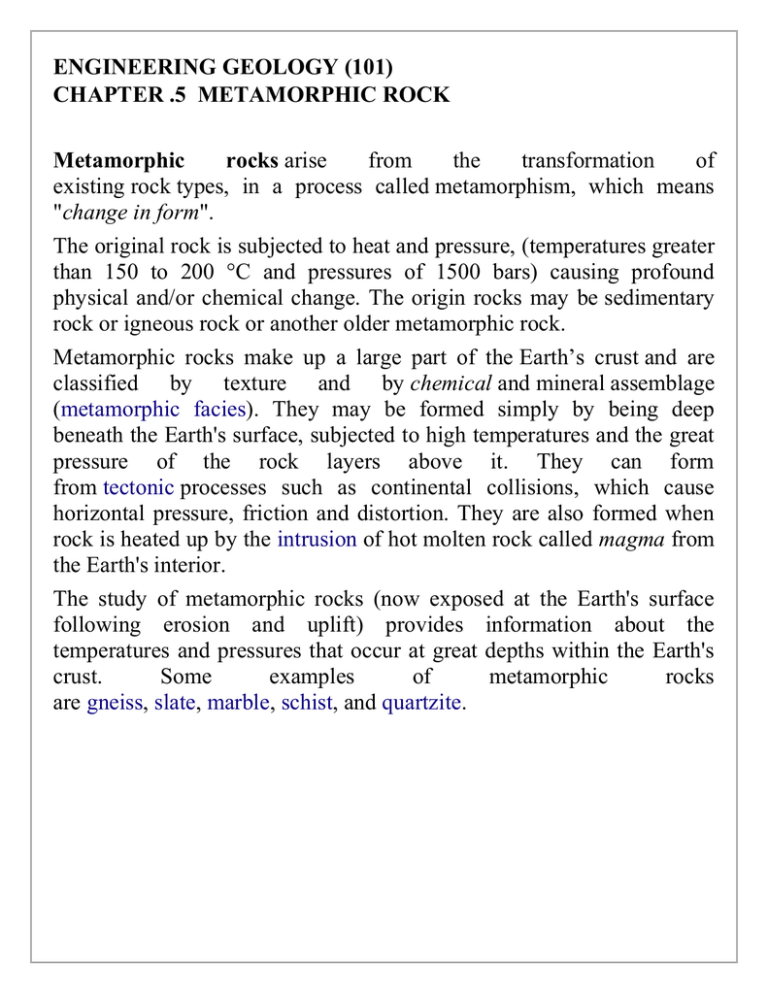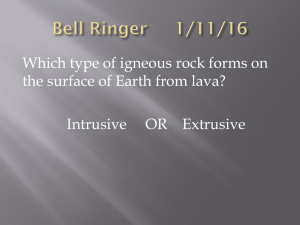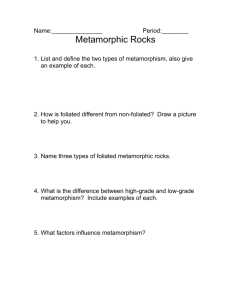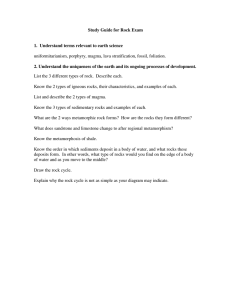CE 101-Chapter Five
advertisement

ENGINEERING GEOLOGY (101) CHAPTER .5 METAMORPHIC ROCK Metamorphic rocks arise from the transformation of existing rock types, in a process called metamorphism, which means "change in form". The original rock is subjected to heat and pressure, (temperatures greater than 150 to 200 °C and pressures of 1500 bars) causing profound physical and/or chemical change. The origin rocks may be sedimentary rock or igneous rock or another older metamorphic rock. Metamorphic rocks make up a large part of the Earth’s crust and are classified by texture and by chemical and mineral assemblage (metamorphic facies). They may be formed simply by being deep beneath the Earth's surface, subjected to high temperatures and the great pressure of the rock layers above it. They can form from tectonic processes such as continental collisions, which cause horizontal pressure, friction and distortion. They are also formed when rock is heated up by the intrusion of hot molten rock called magma from the Earth's interior. The study of metamorphic rocks (now exposed at the Earth's surface following erosion and uplift) provides information about the temperatures and pressures that occur at great depths within the Earth's crust. Some examples of metamorphic rocks are gneiss, slate, marble, schist, and quartzite. Quartzite a form of metamorphic rock Foliation The layering within metamorphic rocks is called foliation (derived from the Latin word folia, meaning "leaves"), and it occurs when a rock is being shortened along one axis during re-crystallization. This causes the platy or elongated crystals of minerals, such as mica and chlorite, to become rotated such that their long axes are perpendicular to the orientation of shortening. These results in a banded, or foliated, rock, with the bands showing the colors of the minerals that formed them. Folded foliation in a metamorphic rock Rocks that were subjected to uniform pressure from all sides, or those that lack minerals with distinctive growth habits, will not be foliated. Slate is an example of a very fine-grained, foliated metamorphic rock, while phyllite is medium, schist coarse, and gneiss very coarse-grained. Marble is generally not foliated, which allows its use as a material for sculpture and architecture. Slate schist Phyllite gneiss Types of metamorphism 1) Contact metamorphism is the name given to the changes that take place when magma is injected into the surrounding solid rock (country rock). The changes that occur are greatest wherever the magma comes into contact with the rock because the temperatures are highest at this boundary and decrease with distance from it. Around the igneous rock that forms from the cooling magma is a metamorphosed zone called a contact metamorphism aureole. Aureoles may show all degrees of metamorphism from the contact area to unmetamorphosed (unchanged) country rock some distance away. The formation of important ore minerals may occur by the process of metasomatism at or near the contact zone. 2) Regional metamorphism is the name given to changes in great masses of rock over a wide area. Rocks can be metamorphosed simply by being at great depths below the Earth's surface, subjected to high temperatures and the great pressure caused by the immense weight of the rock layers above. Much of the lower continental crust is metamorphic, except for recent igneous intrusions. Horizontal tectonic movements such as the collision of continents create orogenic belts, and cause high temperatures, pressures and deformation in the rocks along these belts. If the metamorphosed rocks are later uplifted and exposed by erosion, they may occur in long belts or other large areas at the surface. The process of metamorphism may have destroyed the original features that could have revealed the rock's previous history. Marble







